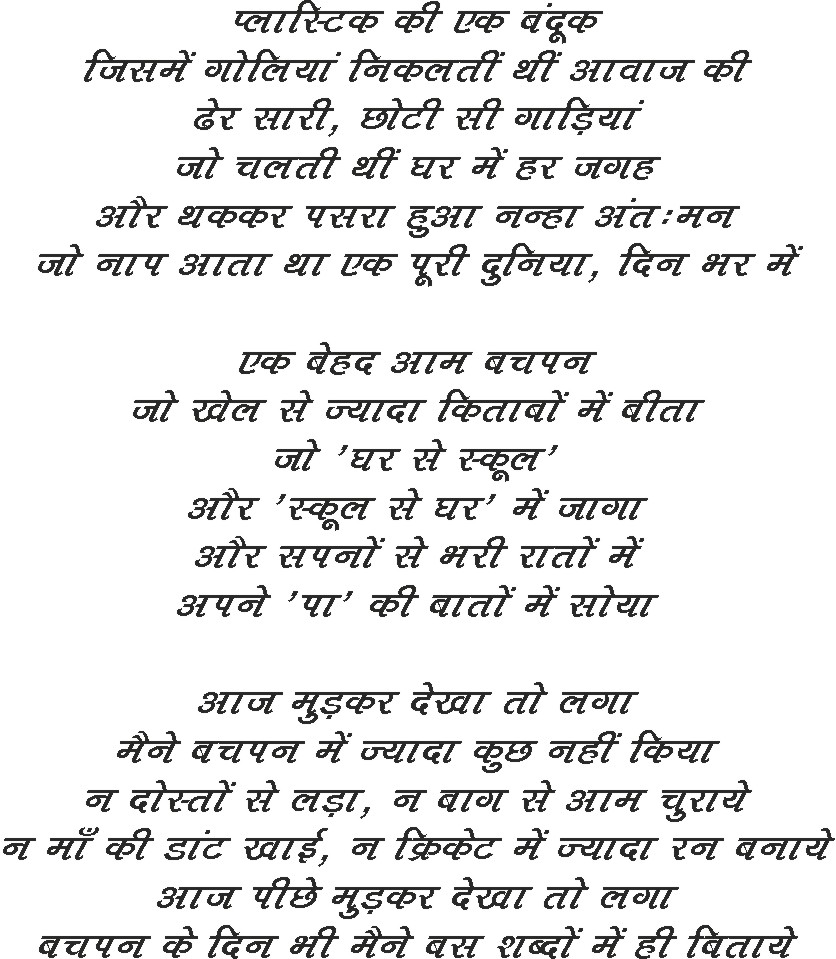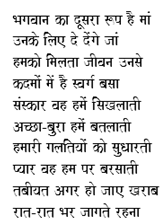Urdu Poetry In Hindi Biography
source:-Google.com.pk
THE MIDDLE period of Hindi literature is identified with the rule of the Moghuls, a time of subjection for the Hindus except for the liberalism practised by Akbar. This period however witnessed an efflorescence of devotional poetry with the rise of religious movements led by men of spiritual vision and poetic gift like Vallabhacharya, Ramananda, Surdas, Tulsidas and Kabir.
These spiritual leaders inspired a democratic spirit of the equality of social classes before God, and a number of men from the lower rungs emerged to preach by example the good life without false pretensions and deceit.
Women-poets like Mira Bai belong to this bhakti milieu; this wave of religious emotion dwindles, giving rise to courtly and conventional poetry of love on well worn lines in post-Akbar times.
This period, called in the history of Hindi literature as "Bhakti" and "Riti-kal", witnessed several women-poets also who have not attracted sufficient attention. They are considered minor poets but their poetic output is worth consideration and assessment in the history of the language.
The author has chosen four minor poetesses; of them three belong to Rajasthan and one, a Muslim woman marrying a Hindu poet-courtier, is inferred to hail from the Punjab. The first three (of which two were of royal lineage) wrote in Brajbasha, the favoured medium of pre-modern standard Hindi and their language employs a mixed vocabulary of Sanskrit, Punjabi, Gujarati, and Arabic-Persian.
Their poems are all individual pieces and one of them has a version of the Srimad Bhagavata. The last mentioned Muslim poetess of Auranga Zeb's time wrote Riti — verses of conventional love — and her inspiration came from her absorption in the Hindu religious ethos. The book needs a bibliography and an index as well.
The 1930s emerged as the archway for entry into a new world and achieve the unachieved. Some young Indians-- Sajjad Zaheer, Mulk Raj Anand, and Mohammad Deen Taseer-- who wee then studying in London, musing on the role of literature in a fast-changing world, came up with a manifesto for what came to be known as the Progressive Writers Movement. Even before this, Sajjad Zaheer, during his stay in India had published Angare (Embers), an anthology of short stories, with explicit ***ual references and an attack on the decadent moral order. The book had to be banned, like Lady Chatterley's Lover, but the stories had an impact, as they were thematically interesting and technically innovative. The reader had suddenly become exposed to the worlds of Freud, Lawrence, Joyce and Woolf. There was a world of new values waiting to be explored by an emotionally charged and intellectually agile reader. the Progressive Writers Movement was launched at the right time. This was the precise hour to she literature in Urdu grew at three different centres: Deccan, Delhi and Lucknow. As it happened, the Deccan emerged as the earliest centre, even though the language had first developed in northern India, as a result of an interesting linguistic interaction between the natives and the Muslim conquerors from Central Asia, who settled there in the twelfth and thirteenth centuries, The period stretching roughly from the middle of the fourteenth centuries to the middle of the eighteenth produce a number of poets. They are claimed both by Urdu and Hindi literary historians, but Quli Qutub Shah (1565-1611) is generally acknowledged as the first notable poet, like Chaucer is English, with a volume of significant poetry in a language later named Urdu. He was followed by several others, among whom Wali Deccani (1635-1707) and Siraj Aurangabadi ( 1715-1763) deserves special mention. Delhi emerged as another significant centre with Mirza Mohammad Rafi Sauda (1713-80), Khwaja Mir Dard (1721-85), Mir Taqi Mir (1722-1810), Mirza Asadullah Khan Ghalib (1797-1869) and Nawab Mirza Khan Dagh (1831-1905). It reached its height of excellence during the eighteenth and nineteenth centuries. Lucknow made its way as the third important centre with Ghulam Hamdani Mushafi (1725-1824), Inshallah Khan Insha (1757-1817), Khwaja Haidar Ali Atish (1778-1846), Iman Baksh Nasikh (1787-1838), Mir Babr Ali Anis (1802-74) and Mirza Salamat Ali Dabir (1803-1875). These literary capitals, where the classical tradition developed, had their individual stylistic and thematic identities.
These spiritual leaders inspired a democratic spirit of the equality of social classes before God, and a number of men from the lower rungs emerged to preach by example the good life without false pretensions and deceit.
Women-poets like Mira Bai belong to this bhakti milieu; this wave of religious emotion dwindles, giving rise to courtly and conventional poetry of love on well worn lines in post-Akbar times.
This period, called in the history of Hindi literature as "Bhakti" and "Riti-kal", witnessed several women-poets also who have not attracted sufficient attention. They are considered minor poets but their poetic output is worth consideration and assessment in the history of the language.
The author has chosen four minor poetesses; of them three belong to Rajasthan and one, a Muslim woman marrying a Hindu poet-courtier, is inferred to hail from the Punjab. The first three (of which two were of royal lineage) wrote in Brajbasha, the favoured medium of pre-modern standard Hindi and their language employs a mixed vocabulary of Sanskrit, Punjabi, Gujarati, and Arabic-Persian.
Their poems are all individual pieces and one of them has a version of the Srimad Bhagavata. The last mentioned Muslim poetess of Auranga Zeb's time wrote Riti — verses of conventional love — and her inspiration came from her absorption in the Hindu religious ethos. The book needs a bibliography and an index as well.
The 1930s emerged as the archway for entry into a new world and achieve the unachieved. Some young Indians-- Sajjad Zaheer, Mulk Raj Anand, and Mohammad Deen Taseer-- who wee then studying in London, musing on the role of literature in a fast-changing world, came up with a manifesto for what came to be known as the Progressive Writers Movement. Even before this, Sajjad Zaheer, during his stay in India had published Angare (Embers), an anthology of short stories, with explicit ***ual references and an attack on the decadent moral order. The book had to be banned, like Lady Chatterley's Lover, but the stories had an impact, as they were thematically interesting and technically innovative. The reader had suddenly become exposed to the worlds of Freud, Lawrence, Joyce and Woolf. There was a world of new values waiting to be explored by an emotionally charged and intellectually agile reader. the Progressive Writers Movement was launched at the right time. This was the precise hour to she literature in Urdu grew at three different centres: Deccan, Delhi and Lucknow. As it happened, the Deccan emerged as the earliest centre, even though the language had first developed in northern India, as a result of an interesting linguistic interaction between the natives and the Muslim conquerors from Central Asia, who settled there in the twelfth and thirteenth centuries, The period stretching roughly from the middle of the fourteenth centuries to the middle of the eighteenth produce a number of poets. They are claimed both by Urdu and Hindi literary historians, but Quli Qutub Shah (1565-1611) is generally acknowledged as the first notable poet, like Chaucer is English, with a volume of significant poetry in a language later named Urdu. He was followed by several others, among whom Wali Deccani (1635-1707) and Siraj Aurangabadi ( 1715-1763) deserves special mention. Delhi emerged as another significant centre with Mirza Mohammad Rafi Sauda (1713-80), Khwaja Mir Dard (1721-85), Mir Taqi Mir (1722-1810), Mirza Asadullah Khan Ghalib (1797-1869) and Nawab Mirza Khan Dagh (1831-1905). It reached its height of excellence during the eighteenth and nineteenth centuries. Lucknow made its way as the third important centre with Ghulam Hamdani Mushafi (1725-1824), Inshallah Khan Insha (1757-1817), Khwaja Haidar Ali Atish (1778-1846), Iman Baksh Nasikh (1787-1838), Mir Babr Ali Anis (1802-74) and Mirza Salamat Ali Dabir (1803-1875). These literary capitals, where the classical tradition developed, had their individual stylistic and thematic identities.









http://www.forumpakistan.com.pk/uljhanparveen-shakir-poetry-t126920.html
ReplyDelete